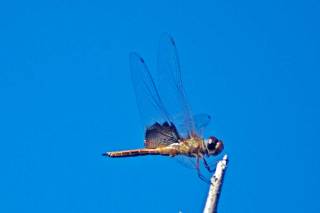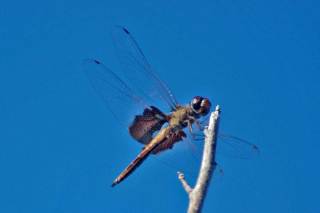I think everyone likes to learn things. I know I do. Last week when I spotted a dragonfly perched in the oak tree out front, I grabbed my camera and binoculars to investigate a bit further. Perched Dragonflies are Much Easier to Identify than Flying Dragonflies.
There are 169 species records in Florida now, but these include both the zygoptera (damselwings) and the anisoptera (dragonflies); I’m not sure what the breakdown between the two groups is. [UPDATE: According to this website, there are now 123 dragonfly species in the state, and 47 damselfly species, which brings us up to 170 as of 2007. Hmmmm…..] Back in 1989, when Sidney Dunkle published his groundbreaking field guide to the state, he included 86 dragonfly species (94 with Bermuda and the Bahamas included); I wonder if there have been enough changes to the list to require a new field guide to Florida? [John Epler’s 123 species certainly seems to argue for an update.]
Whichever number you like, 169 or 93, it’s a tolerably round number for a group of insects that are as hard to chase down as odonates. Even though there are only seven families of dragonfly species in both Americas, I still can’t separate many of them in the field even to the family level; it’s only with a camera that I stand a chance. I’m trying to change that, little by little, by learning the species that occur commonly, so that I’ll recognize anything new. (If anyone has a simple flight silhouette technique for sorting out, skimmers and darners at a glance, I’d love to buy it! The keys in my major reference works are either too complex, like the one in Garrison, Ellenrieder, & Louton, which includes all the genera of North and South America, or, if they’re as straightforward as the one in Mitchell & Lasswell, it still requires that you have the insect in hand.)
Part of my problem, I think, is that most of the species I see are members of the Libellulidae, the skimmer family. Large and diverse as it is, it’s still only one of the seven families; it’s pretty rare that I see other flight silhouettes at all! (Last Saturday at Yamato Scrub I got excited because I saw a silhouette I didn’t recognize; turned out to be some kind of sphecid wasp.) If I don’t often see the other silhouettes, I’ll have a hard time learning them, won’t I? (Guess I’d better get out in the field more often…) As you know, there are, according to Odonata Central, 53 distinct species in Palm Beach County.
Here then, is a typical silhouette of a libelullid, or skimmer, as seen by me in a tree:
This species, Tramea carolina, a member of the skimmer family, is fairly common in my area. Most people call it Carolina Saddlebags, because of the large markings on the hindwing; they really do sort of look like the thing is carrying luggage back there!
However, if you click on that link in the previous paragraph (the #1 Google link for Carolina Saddlebags), you’ll see why I might prefer the more descriptive name given to it in 1989 by Sidney W. Dunkle, in the first ever color photo guide to dragonfly species anywhere in North America: Violet-masked Glider. After all, that #1 linked-to page on the Carolina Saddlebags is to a website describing the dragonflies of New Jersey!
I like that name better for a couple of reasons. One, it avoids the tendency that has fouled up the common names of birds for centuries, that being to name a species based on a location that it might or not occur in, just because that’s where the first specimen was encountered. Two, it’s descriptive.
Whatever name they go by, though, they certainly are distinctive dragonflies; when I see these guys, I know I’m looking at a skimmer, probably a Tramea species, and I even have a good shot of telling whether it’s a Carolina or a Red. It’s a start!
References
Dunkle, S.W. (1989). Dragonflies of the Florida Peninsula, Bermuda and the Bahamas. Gainesville: Scientific Publishers.
Garrison, R.W., Ellenrieder, N.V., Louton, J.A. (2006). Dragonfly Genera of the New World. Baltimore: Johns Hopkins UP.
Mitchell, F.L. & Lasswell, J.L. (2005). A Dazzle of Dragonflies. Texas A&M UP.


